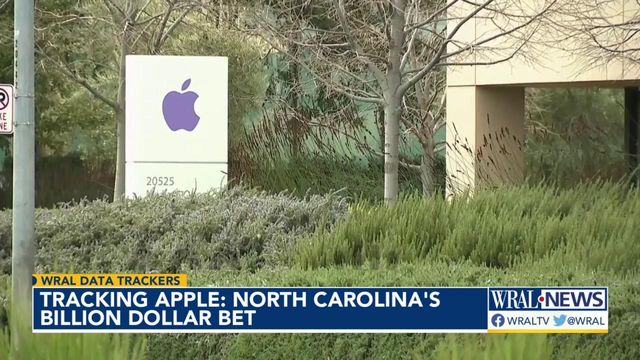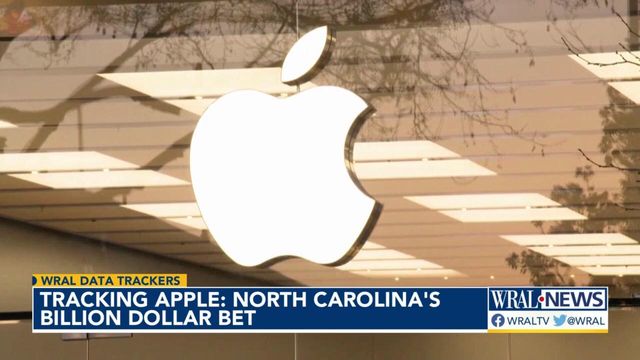North Carolina offering more incentives to Apple than every other state combined, records show
WRAL Data Trackers looked through the numbers to see if and how the massive investment might pay off.
Posted — UpdatedThe company’s expansion and latest commitment to North Carolina includes adding 3,000 jobs and investing a billion dollars into the economy here through that campus at RTP. The state propositioned the corporation with a hefty incentive package.
A new WRAL analysis shows not only is it the largest in the company’s history but it is more than they receive from every other state company combined.
Good Jobs First is a group that promotes accountability in economic development.
Not only is that the highest incentive amount from any state where records are available but it is 2.5 times the total amount Apple has received from every other state combined.
“Apple’s a game changer,” said Dr. Mike Walden, an economist who developed the Walden Model. “It's an iconic firm, it's going to encourage growth and the triangle.”
The state uses an algorithm Walden created to weigh the pros and cons of offering incentives to large corporations like Apple.
“This is a poker game, in some sense,” said the retired NC State professor. “North Carolina is now participating with a lot of chips.”
The model is like a scale and calculates the economic impact - both direct and indirect, Walden explained. Those include employee salaries and tax revenue generated, along with impacts for local suppliers and increased retail sales. In all, the model estimates that would be around $3.4 billion a year.
Then, the model compares those benefits to the costs like how much the state will lose in tax revenue from the incentives, along with other costs like the ones related to public services. In this case, it is estimated at $1.4 billion. So the state stands to make $2 billion each year while paying just up to $28 million annually in incentives for the 39-year term.
However, opponents say grants and incentives give corporations an unfair advantage.
“The taxes that those corporations are not paying need to be made up by somebody and that somebody is going to be all the other business owners and entrepreneurs across the state,” said Brian Balfour, with the John Locke Foundation.
Balfour feels Apple doesn’t need the financial help. In 2021, the company’s public filings reveal their revenue grew to more than $365 billion, meaning they were making about a billion dollars every day.
A notable difference, though, is the types of jobs there. The average salary for a worker at the site outside of Austin topped out at $73,500 a year whereas the RTP gigs are offering about $100,000 more than that every year. The high value of the 3,000 Apple jobs is a key driver to the value of the incentives.
State officials told WRAL Data Trackers they believe their offer now was competitive and that’s why Apple ultimately chose North Carolina.
During this latest expansion, records show Apple considered Ohio as well where there aren’t any corporate income tax, personal property tax and low sales taxes rates.
In the records request detailing the workings of the deal, the state reported that Ohio also offered lucrative incentives such as state level economic development grants and R&D specific grants. But North Carolina, it seems from the records, ultimately had more to offer.
Aside from incentives, the company noted other reasons they were attracted to the triangle include accessibility, attractable talent, real estate and building costs, and tax burden.
Walden notes the company moving here doesn’t come without any downsides though. He pointed to the area’s competitive housing market and rising rent prices as well as concerns about infrastructure and traffic. The economist doesn’t believe that’ll all fall on Apple though. He feels that company’s move to the Triangle will entice other corporations to come here too, without having to offer them incentives.
“I think for Raleigh and for the triangle, it just increases our status,” Walden said. “So, it's likely to improve and enhance your economic growth.”
Related Topics
• Credits
Copyright 2024 by Capitol Broadcasting Company. All rights reserved. This material may not be published, broadcast, rewritten or redistributed.






